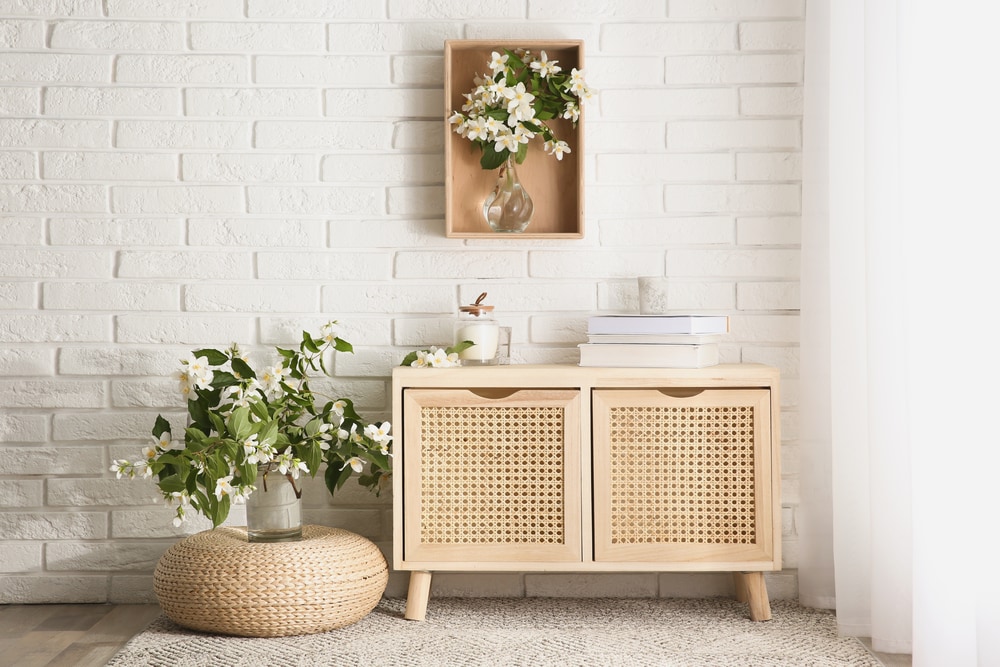CAN YOU PAINT TILE AND SAVE MONEY AT HOME?
Have you ever thought of painting your ceramic tiles but didn’t know where to start? Or are you unsure whether you can even paint tiles at home? Well, the short answer to “Can you paint tile?” is YES!
Don’t fret! In this guide, we are going to show you how you can paint your tiles, the benefits of painting tiles, what you need to consider, and everything else related to painting tiles and other similar items.
This post may contain affiliate links. If you choose to purchase a recommended product, I may receive a small commission at no additional cost to you. Rest assured that I will not recommend any product that I would not use myself. For our full policies and disclosures click here.

Can you paint old tile and what are the benefits?
The quick answer is yes, it is possible to paint tiles at home. Tiles used in the house in different rooms, such as bathrooms, kitchens, and walls, are usually made of porcelain, ceramic, and other material that can be easily painted if prepared sufficiently.
Tile is a surface that is known as hard to treat owing to its glossy nature, which can make the paint not adhere as needed. However, tiles can be painted with multiple products that can be applied on several surfaces, including plastics, metal, masonry, wood, and UPVC.
Here are some benefits of painting tiles you should consider:
- Painting tiles is more cost-effective than replacing new tiles.
- Paints are available in many colors and shades you can choose from, allowing you to choose any color you want for your room.
- It causes less distraction compared to full replacement, which might result in other unnecessary projects like filling the entire floor or wall and other materials like plumbing lines and electrical systems.
Potential Drawbacks and Limitations to painting tile
While painting tile offers numerous advantages, it’s important to consider potential drawbacks and limitations. For example, painted tile may require more maintenance than its original form, and the paint may not adhere well to certain types of tiles.
Additionally, heavily used areas such as floors or kitchen countertops may experience faster wear and tear. Also, as discussed earlier in this post, painting tile needs a lot of preparation, making the entire process time-consuming.
However, with proper preparation and maintenance, you can easily mitigate these concerns. While painting tile can be considered a DIY project, it is advised to get professional painters’ advice to help you handle these drawbacks.
Long-term solutions vs alternatives
Before diving into the process of painting tile, it’s worth considering long-term solutions and alternative options available. While replacing them entirely is one of the notable long-term approaches, it can be costly and time-consuming.
On the other hand, it is a great way to achieve a fresh look quicker. Comparing painting to other alternatives like adhesive decals, or replacing the tile with new tile, painting allows for greater customization and durability.
How to prepare the tile for the painting project?
Like other painting tasks, you will need to do some surface preparation before undertaking the actual work. Below is the procedure for doing tile surface preparation:
1. Assess the condition of the tile Before beginning your tile painting project: It’s essential to assess the condition of the tile. Look for cracks, chips, or loose pieces that may need repair before painting. Smooth surfaces will yield the best results.
2. Gather the necessary materials and tools: To ensure a successful paint job, it’s a good idea to gather all the necessary materials and tools ahead of time. These may include paint, primer, brushes, rollers, painter’s tape, cleaning supplies, clean water, and protective gear. Having everything ready beforehand will make the process more efficient.
3. Cleaning the tile surface Properly: Cleaning the tile surface is crucial for optimal paint adhesion. Remove any dirt, grease, or grime using appropriate cleaners such as Krud Kutter, or TSP. Ensure the tiles are completely dry before moving on to the next step.
4. Choosing the Right Paint for the Tile: Differentiate between the different types of tile and their suitability for painting. Not all tiles are suitable for painting. Ceramic, porcelain, and stone tiles are good candidates, while certain types, like glass or highly glazed tiles, may not adhere well to paint. Understand the type of tile you have to determine its paintability.
How to choose the right paint finish for your tile?
Choosing the best paint for your tile painting job is a crucial factor that needs professional painters’ advice and supervision, especially if you are a newbie painter. While you might have fewer options regarding the type of paint finish to choose from, there are enough options that can fit your needs.
Look for paints that offer durability, moisture resistance, and easy cleaning. Acrylic latex or epoxy paints are often recommended for their excellent adhesion and durability. Epoxy paint provides exceptional durability and is ideal for high-traffic areas or other areas that receive a lot of wear and tear, while ceramic tile paint offers specialized formulas designed for tile surfaces. However, they need more specialized attention. And you can get paints for specific areas such as floor paint made especially for high foot traffic areas.
Step-by-Step Guide to Painting Tile
Before we jump into the steps, let’s look at the materials and supplies you should have ready with you:

- Painter’s tape
- Newspaper or drop cloth
- Cleaning supplies
- Sanding paper (200 and 400 grit-sandpaper)
- Protective gears
- The paint and the primer of your choice
- A paintbrush
- Putty knife
- Any other necessary supplies
Step 1: Prepare the area and clean the surface
This step involves preparing the tile surface, utilizing a bonding primer for effective adhesion, and protecting the surrounding areas.
- Thoroughly clean the tile surface again, ensuring it is free from dust, grease, and any remaining residue. Use a mild abrasive cleaner or sandpaper to roughen the surface lightly, which helps the primer and paint adhere better.
- Apply a bonding primer specifically designed for tile surfaces. This primer creates a strong bond between the tile and the paint, ensuring long-lasting adhesion. Follow the manufacturer’s instructions for application and drying times.
- Remove any loose debris and tape off adjacent areas with painter’s tape. Cover fixtures, countertops, or furniture with drop cloths to prevent accidental paint splatters.
Step 2: Use painter’s tape for clean edges
To maintain clean and crisp edges, use painter’s tape along the borders of the painted tile. This helps to prevent paint from bleeding onto grout lines and other surfaces. Remove the tape carefully after the final coat of paint has dried.
Step 3: Apply the first coat of primer
Using a roller or brush, apply the first coat of primer on the cleaned surface. Start working on small sections while applying thin, even coats.
Allow the primed section to dry completely before moving to the next step, which is the paint application.

Step 4: Apply the paint
Once the primer is dry, it’s time to apply the first coat of paint. Work in small sections, starting from one corner and moving across the tile.
Use a brush or roller to apply thin and even coats of paint. Avoid applying thick coats, as it may lead to drips, uneven drying, or extended drying time. This approach ensures that you achieve a smooth and professional finish.
Step 5: finishing touches for a long-lasting outcome
For better and long-lasting results, it is recommended that you apply a second coat of paint once the first one has dried completely. Use the method of applying paint discussed above to apply this second coat. The additional coat will ensure full coverage of the surface and improve the durability of the painted area.
Take extra measures to improve the durability of the painted surface, especially in high-traffic areas, by using a clear sealing top coat. You can also use mats or rugs on the area and avoid the use of abrasive cleaners. Always clean any spills immediately after they occur to prevent staining.
Step 6: Cleaning up and removing painter’s tape
Once you’ve completed the painting process, carefully remove the painter’s tape to reveal clean edges. Clean up any drips or spills using a damp cloth or the appropriate cleaning method recommended for the paint you use.

Considerations for Specific Tile Areas
Bathroom floors and walls
Painting bathroom tile floors and walls can bring a fresh and updated look to your space. Ensure you choose durable and moisture-resistant paint that can withstand a humid environment. Proper surface preparation and sealing are vital for the longevity of your bathroom tiles.
Kitchen Backsplash
Transform your kitchen by painting the tile backsplash. Opt for a paint that is heat-resistant and easy to clean for your kitchen tile, as these areas are prone to splatters and spills. Consider coordinating the paint colors with your overall kitchen design for a cohesive look.
Shower tiles and laundry rooms
If you’re looking to refresh your shower wall tile or laundry room, painting them can make a significant impact. Select a paint that is specifically designed for wet areas and has excellent mold and mildew resistance. Ensure proper ventilation in these spaces to prevent moisture buildup.

Conclusion
Painting tile surfaces is a rewarding and cost-effective way to transform your space. By following the step-by-step guide, you can achieve professional-looking results. From assessing the tile condition to choosing the right paint and applying it correctly, each stage contributes to a successful project.
Remember to prioritize proper surface preparation, choose high-quality materials, and follow the recommended techniques. With patience, attention to detail, and a little creativity, you’ll achieve remarkable results that will breathe new life into your home.
So, why wait? Grab your paintbrush and start your tile painting project today! Enjoy the process and the stunning transformation that awaits you.
ABOUT THE AUTHOR

Mark Heaton is a professional painter with a knack for anything painting. He founded Pro Painters Guide to help readers, novices, and DIYers gain valuable information on painting and complete their projects successfully.



